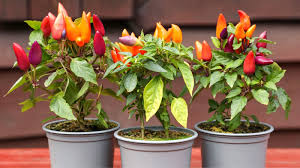Growing peppers in pots or containers is an excellent way to enjoy fresh, flavorful peppers, whether you’re a seasoned gardener or just starting out. This method is ideal for small spaces, offering convenience and control over growing conditions. Here’s a detailed, step-by-step guide to help you cultivate healthy pepper plants and achieve a bountiful harvest.
Step 1: Choose the Right Pepper Varieties
Select compact or dwarf pepper varieties that thrive in containers. Popular choices include sweet bell peppers, jalapeños, and other small-sized chili peppers, as they require less space and are easier to manage.
Step 2: Select the Right Container
Choose a container at least 12 inches deep with drainage holes to prevent waterlogging. Larger pots retain moisture better, reducing the risk of dehydration, and support robust root development.
Step 3: Use High-Quality Potting Mix
Fill your container with a nutrient-rich, well-draining potting mix. Avoid using garden soil, which can be dense and may harbor pests or diseases. Mix in compost or organic matter for added nutrients.
Step 4: Planting the Seeds
Sow seeds about 1/4 inch deep, spacing them at least 2 inches apart if planting multiple seeds in the same container. Lightly water the soil to keep it moist but not saturated.
Step 5: Promote Germination
Place the pots in a warm, brightly lit area. Pepper seeds germinate best in temperatures between 70°F and 90°F, typically sprouting within 7–14 days. Consider using a seedling heat mat for consistent warmth.

Step 6: Thinning and Transplanting
When seedlings develop two sets of true leaves, thin out the weaker ones, leaving the strongest in each pot. If you started seeds in small containers, transplant them to larger pots at this stage.
Step 7: Watering and Fertilizing
Water your plants consistently, allowing the top inch of soil to dry out between waterings. Overwatering can cause root rot. Feed your peppers every 2–3 weeks with a balanced, water-soluble fertilizer to promote growth and fruit production.
Step 8: Provide Adequate Sunlight
Peppers need at least 6–8 hours of sunlight daily. If natural light is insufficient, use grow lights to supplement their needs.
Step 9: Pruning and Support
Prune your plants to encourage bushy growth and increase yields. Remove lower leaves and weak branches. Support the plants with stakes or cages to keep them upright as they grow and bear fruit.
Step 10: Manage Pests and Diseases
Regularly inspect plants for pests such as aphids, spider mites, and whiteflies. Treat infestations promptly with insecticidal soap or neem oil. To prevent fungal diseases, avoid overhead watering and ensure good air circulation around the plants.
Step 11: Harvesting Your Peppers
Harvest peppers when they reach the desired size and color. Use scissors or pruners to cut them from the plant, minimizing branch damage. Frequent harvesting encourages the plant to produce more fruit.
Conclusion
Growing peppers from seeds in containers is a rewarding and space-efficient way to cultivate fresh produce. With proper care, pest management, and attention to detail, you can enjoy a thriving pepper garden that enhances your meals and connects you to the joys of homegrown food. Happy gardening!
